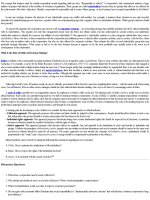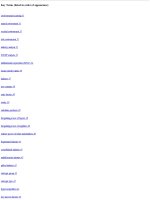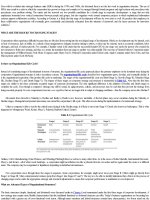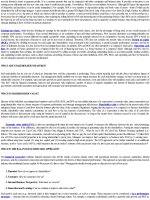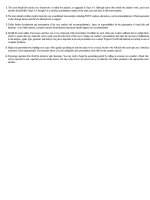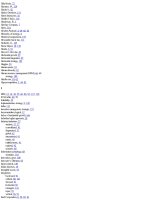Essentials of contemporary management 5th canadian edition by jones george haddad test bank
Bạn đang xem bản rút gọn của tài liệu. Xem và tải ngay bản đầy đủ của tài liệu tại đây (281.79 KB, 20 trang )
Essentials of Contemporary Management 5th Canadian edition by Gareth R. Jones, Jennifer M. George,
Jane Haddad Test Bank
Link full download test bank: />Link full download solution manual: />TRUE/FALSE. Write 'T' if the statement is true and 'F' if the statement is false.
1) Globalization has resulted in restricted capital flows.
Answer:
True
2) Globalization
Answer:
3) With
False
is a set of forces that work together to integrate and connect systems across countries.
True
False
globalization, nations become increasingly similar and interdependent.
Answer:
True
False
4) The organizational
environment changes over time and therefore presents managers
with opportunities and threats.
Answer:
True
False
5) The organization's
internal environment is divided into the task environment and the
general environment.
Answer:
True
6) The internal
Answer:
False
organizational environment includes the culture and structure of the organization.
True
False
7) The task
or industry-specific environment is a set of external forces that affect an
organization's ability to obtain inputs and dispose of outputs.
Answer:
True
False
8) The task
or industry-specific environment includes economic, technological, sociocultural, demographic, political and legal, and global forces.
Answer:
True
False
9) The general
environment includes economic, technological, socio-cultural, demographic,
political and legal, and global forces.
Answer:
True
10) The general
Answer:
False
environmental forces pose easily identifiable opportunities and threats for managers.
True
False
11) Forces
in the task or industry-specific environment have immediate and direct effects on a
managers' ability to obtain resources or sell an organization's goods and services.
Answer: True
12) Overseas suppliers
Answer:
True
False
are increasingly specializing in just one part of the task of producing a product.
False
13) The power
of a distributor may get stronger if there are too many options for manufacturers
and wholesalers to sell their products directly to customers.
Answer:
True
False
1
14) Suppliers
are individuals or firms that provide an organization with inputs that it needs to
produce goods and services.
Answer:
True
False
15) Differences
in customer preferences result in many companies standardizing products for
different national markets.
Answer:
True
False
16) The suppliers,
customers, and distributors that affect the organization's ability to obtain inputs
and to sell its outputs are forces in the task or industry-specific environment.
Answer:
True
False
17) The wide ranging set
of forces and conditions that operate beyond an organization's boundaries
and affect the organization are known as forces in the general environment.
Answer:
True
False
18) For
the typical manager, opportunities and threats which result from changes in the task or industryspecific environment are more difficult to identify than events in the general environment.
Answer:
True
19) The task
Answer:
False
environment is also known as the industry-specific environment.
True
False
20) Organizations
which help other organizations to sell their goods and services to customers are
known as distributors.
Answer:
21) Groups
Answer:
True
False
which buy goods that another organization produces are known as suppliers.
True
False
22) An
organization's "competitors" are those organizations which try to sell their goods to the
same customers as the organization is trying to sell its goods.
Answer:
23) A
True
False
shift in the age distribution of the population of Canada is an example of a demographic force.
Answer:
True
False
24) The outcomes
of the changes in the laws of a country are examples of the political and legal
forces in the environment.
Answer:
True
25) Economic forces
Answer:
True
False
in the general environment include interest rates, inflation, and unemployment.
False
2
26) The global
financial meltdown in 2008 was a result of too much risk-taking and not
enough oversight.
Answer:
True
27) The manager's
Answer:
job is being fundamentally changed by new technology.
True
28) The social
Answer:
False
structure of a country affects the socio-cultural forces acting on organizations.
True
29) Declining barriers
Answer:
False
True
False
to trade and investment have facilitated globalization.
False
30) The free-trade doctrine predicts
that if each country agrees to specialize in the production of the
goods and services that it can produce most efficiently, this will make the best use of global
capital resources and will result in lower prices.
Answer:
True
False
31) Barriers
of distance and culture have closed the global environment and kept managers focused
on their domestic market.
Answer:
True
False
32) Since the
end of the Second World War, a continuing stream of advances in communications
and transportation technology has worked to reduce the barriers of distance and culture that
affected Unilever and all global organizations.
Answer:
True
False
33) One of
the most important innovations in transportation technology that has opened the
global environment has been the growth of commercial jet travel.
Answer:
True
False
34) The establishment
of free-trade areas creates an opportunity for manufacturing
organizations because it lets them reduce their costs.
Answer:
True
False
35) Some
managers view regional free-trade agreements as a threat because they expose a company
based in one member country to increased competition from companies based in the other
member countries.
Answer:
True
False
36) In
general, the larger an organization is, the greater is the number of environmental forces
that managers must respond to.
Answer:
37) There
True
False
are four principal forms of capital flow between countries in the global economy.
Answer:
True
False
3
38) The task
of the top-management team in reducing the impact of environmental forces, is to
create strategies that will take advantage of opportunities and counter threats.
Answer:
True
39) The main
Answer:
False
task of middle managers is to collect relevant data on forces in the task environment.
True
False
40) Marketing department
Answer:
41) Sales
True
managers handle pressures from suppliers.
False
and service department managers handle pressures from customers.
Answer:
True
42) Financial
Answer:
43) Changes
False
managers and accounting departments handle the forces in the economic realm.
True
False
in technological forces are dealt with by Research and Development department managers.
Answer:
True
False
44) The highest
degree of uncertainty for a manager occurs when the rate of change and the degree
of complexity in the environment is high.
Answer:
True
False
45) By better
connecting companies' success with societal improvement, it opens up many ways to
serve new needs, gain efficiency, create differentiation, and expand markets.
Answer:
True
False
46) Shared
value creation focuses on identifying and expanding the connections between societal
and economic progress.
Answer:
True
False
47) The prominence of
global organizations is putting pressure on managers of all organizations
to improve their performance.
Answer:
48) To
True
False
gain a competitive advantage in the global economy, firms can use five building blocks.
Answer:
True
False
49) The four building blocks
of a competitive advantage are increasing efficiency, offering
superior quality, creating new or better products, and being responsive to customer needs.
Answer:
True
False
50) Managers
face the following challenges in today's global economy: creating shared value in
building a competitive advantage, maintaining ethical standards, and utilizing new technologies.
Answer:
True
False
4
MULTIPLE CHOICE. Choose the one alternative that best completes the statement or answers the question.
51) Which
of the following represents a threat to managers by large distributors?
A) Increasing orders
B) Socio-cultural impact
C) Controlling customer access to an organization's goods and services
D) Changing demographics
E) None of these choices are correct
Answer: C
52) Which
of the following could be an example of a customer of a computer manufacturer, such
as Acer Canada?
A) small businesses
B) individuals
C) government agencies
D) colleges
E) all of these choices are correct
Answer: E
53) The combination
of equipment and skills which managers use in the production and distribution of
goods is known as:
A) competitive advantage
B) technology
C) inflation
D) economies of scale
E) the general environment
Answer: B
54) All
of the following are examples of the industry-specific or task environment of the organization
EXCEPT:
A) competitors
B) customers
C) technological forces
D) suppliers
E) distributors
Answer: C
55) Organizations
which produce goods that are similar to another organization's goods are known as:
A) distributors
B) suppliers
C) customers
D) competitors
E) none of the choices
are correct
Answer: D
5
56) Regional
trade agreements like NAFTA result in all except which of the following?
A) Declining barriers to trade
B) Decline in labour intensive production in Canada and the USA
C) Increased capital flows between partner nations
D) Decreased competition
E) Opportunities for managers to expand internationally
Answer: D
57) All
of the following are examples of the general environment of the organization EXCEPT:
A) global forces
B) demographic forces
C) legal and political forces
D) distributors
E) technological forces
Answer: D
58) Organizations
which supply another organization with the raw materials which it needs to
produce goods are known as:
A) customers
B) suppliers
C) distributors
D) competitors
E) potential competitors
Answer: B
59) Organizations
which help other organizations to sell their goods to customers are known as:
A) potential competitors
B) distributors
C) competitors
D) customers
E) none of these choices are correct
Answer: B
60) Changes in
the work patterns of women such as a larger percentage of mothers with children under the
age of five are working would be an example of which type of force on the organization?
A) general environment
B) political environment
C) task environment
D) legal environment
E) economic environment
Answer: A
6
61) If
a major firm suddenly creates a new product which makes the products of its
competitors obsolete, this is an example of a force in which type of environment?
A) economic environment
B) general environment
C) political environment
D) legal environment
E) task environment
Answer: E
62) The outcomes
of the changes in the laws of a society are known as:
A) political and legal forces
B) technological forces
C) demographic forces
D) economic forces
E) none of the choices are correct
Answer: A
63) Social
structure and national culture are examples of which type of force in the
general environment?
A) political and legal forces
B) economic forces
C) demographic forces
D) technological forces
E) none of the choices are correct
Answer: E
64) __________
are outcomes of changes in international relationships, changes in nations'
economic, political, and legal systems, and changes in technology.
A) Economic systems
B) Political systems
C) Technologies
D) Global forces
E) Legal systems
Answer: D
65) The four building blocks
of a competitive advantage are:
A) Effectiveness, quality, customer responsiveness, innovation
B) Efficiency, quality, customer responsiveness, innovation
C) High performance, quality, efficiency, innovation
D) Efficiency, effectiveness, quality, customer responsiveness
E) Effectiveness, customer responsiveness, innovation, efficiency
Answer: B
7
66) Which
of the following is an example of a political and legal force in the environment?
A) privatization
B) emphasis on environmental protection
C) emphasis on safety on the job
D) deregulation
E) all of these choices are correct
Answer: E
67) Modern
communications and transportation technologies have done all but this:
A) Increased barriers to trade and investment
B) Speeded travel
C) Facilitated global communication networks
D) Reduced the cultural differences among countries
E) Made reliable, secure, and instantaneous communication possible
Answer: A
68) The path
of globalization is shaped by the ebb and flow of which types of capital?
A) Political
B) Resource
C) Financial
D) Human
E) All of the choices are correct
Answer: E
69) Which
of the following is a task of the top-management team in reducing the impact
of environmental forces?
A) Collect relevant information on the task environment.
B) Get close to customers to learn what they want.
C) Find ways to use resources more efficiently.
D) Create strategies that will take advantage of opportunities and counter threats.
E) None of these choices are correct.
Answer: D
70) Which
of the following is a task of the middle manager in reducing the impact of
environmental forces?
A) Create strategies that will take advantage of opportunities and counter threats.
B) Get close to customers to learn what they want.
C) Find ways to use resources more efficiently.
D) Collect relevant information on the task environment.
E) None of these choices are correct.
Answer: D
8
71) The organizational
environment is comprised of:
A) Forces that present managers with opportunities
B) Forces that present managers with threats
C) Forces that are internal to the organization
D) Forces that are external to the organization
E) All of these choices are correct
Answer: E
72) Which
of the following is a tax that a government imposes on goods imported into one country
from another?
A) Tariff
B) Inflation
C) Interest rates
D) GATT
E) All of the choices are correct
Answer: A
73) Which
of the following is an economic force in the environment?
A) economic growth
B) inflation
C) interest rates
D) unemployment
E) all these choices are
correct
Answer: E
74) Historically,
barriers of distance and culture closed the global environment because:
A) Communication over great distances was difficult
B) Business was difficult to control over great distances
C) International telephone and telegraph services were unreliable
D) Different countries have different sets of national beliefs, values, and norms
E) All of the choices are correct
Answer: E
75) The population
of Canada is "aging" in the sense that the average age of Canadians increases
each year. This is an example of which type of force in the environment?
A) technological
B) economic
C) political
D) demographic
E) legal
Answer: D
9
76) Pressures
from customers are handled by:
A) Finance and Accounting departments
B) Legal and Public Relations departments
C) Sales and Services departments
D) Research and Development departments
E) Marketing departments
Answer: C
77) Pressures
from competitors are handled by:
A) Legal and Public Relations departments
B) Finance and Accounting departments
C) Research and Development departments
D) Sales and Services departments
E) Marketing and Strategy departments
Answer: E
78) Changes
in technological forces are handled by:
A) Marketing departments
B) Finance and Accounting departments
C) Sales and Services departments
D) Legal and Public Relations departments
E) Research and Development departments
Answer: E
79) Changes
in economic forces are handled by:
A) Marketing departments
B) Legal and Public Relations departments
C) Research and Development departments
D) Finance and Accounting departments
E) Sales and Services departments
Answer: D
80) The impact
of national culture on managing in a global economy means that:
A) Organizations with international management teams are role models
B) Managers must understand, empathize, and work with multiple cultures
C) Managers must better appreciate how cultures differ
D) Countries with a great deal of diversity will produce great global managers
E) All of these choices are correct
Answer: E
10
81) The set
of forces which lead to interdependence and similarities among nations is known as:
A) social structures
B) national cultures
C) the organizational environment
D) stakeholders
E) globalization
Answer: E
82) The organization's
external environment can be divided into these categories:
A) Organizational structure
B) Organizational culture
C) Internal threats and opportunities
D) Strengths and weaknesses
E) Task or industry-specific and general environments
Answer: E
83) When
an organization's customers put pressure on the organization to reduce prices on its
goods, this is a force in the organization's:
A) industry-specific environment
B) socio-cultural environment
C) political environment
D) legal environment
E) general environment
Answer: A
84) Individuals
who buy goods that an organization produces are known as:
A) customers
B) distributors
C) suppliers
D) potential competitors
E) competitors
Answer: A
85) Globalization
is driven by the free movement of which of the following?
A) Human capital
B) Financial capital
C) Political capital
D) Resource capital
E) All of these choices are correct
Answer: E
11
86) Which
of the following is an example of a demographic force in the environment?
A) sexual orientation
B) race
C) ethnic origin
D) gender
E) all of these choices are correct
Answer: E
87) The degree to
which forces in the environment change over time is known as
A) economic change
B) technological change
C) sociocultural change
D) environmental change
E) political change
Answer: D
88) Which
of the following is an example of a force in the task or industry-specific environment of
an organization?
A) customers
B) competitors
C) distributors
D) suppliers
E) all of these choices are correct
Answer: E
89) When
a competitor negotiates a long-term contract with a supplier of raw materials, this is an
example of an impact on your organization's:
A) general environment
B) task environment
C) legal environment
D) political environment
E) socio-cultural environment
Answer: B
90) If
the population of Canada is shifting from the East to the West, this is an example of which type
of force in the environment?
A) Political
B) Legal
C) Demographic
D) Economic
E) Technological
Answer: C
12
91) Which
of the following is included in the organization's general environment?
A) global forces
B) socio-cultural forces
C) legal and political forces
D) technological forces
E) all these choices are correct
Answer: E
92) Forces
within the organization which result from the organization's structure and culture are
known as:
A) the general environment
B) the task environment
C) the internal environment
D) the external environment
E) none of the choices are correct
Answer: C
93) Overseas
suppliers can pose a threat to managers of organizations in all but one of the
following ways:
A) They are the sole source of an input.
B) They offer low cost, high quality parts/inputs.
C) The input is vital to the organization.
D) If their position is strong.
E) None of these choices are correct.
Answer: B
94) Canadian
managers face two main challenges in the global environment, including:
A) building a competitive advantage while maintaining ethical standards, and utilizing new
kinds of information systems and technologies
B) managing a diverse and aging work force
C) organizational size and types
D) the political and legal climates
E) reliance on fossil fuel and industrial technology
Answer: A
95) Managers
face a number of challenges in the global environment, including:
A) creating shared value
B) managing a diverse work force
C) the political and legal climates
D) the types of organizations
E) organizational size
Answer: A
13
SHORT ANSWER. Write the word or phrase that best completes each statement or answers the question.
96) Explain
how managers can minimize threats and uncertainty from forces in the external
environment. Identify three forces from your own experience that contribute to the complexity
and rate of environmental change.
Answer: Managers must minimize threats from the forces that affect their organization's task
environment and general environment by understanding the two factors that affect the degree
of uncertainty: Two factors affect the nature of the opportunities and threats that
organizations face: First, the level of complexity in the environment and second, the rate of
change in the environment. The degree of uncertainty in the environment affects the decisions
managers make to handle risks and threats. Top managers devise strategies to explore
opportunities and counter threats to the entire organization. Middle managers gather relevant
information on the forces acting in the task environment that will impact strategies to gain a
competitive advantage. First line managers find ways to use resources efficiently and add
value for the customer to build brand loyalty. The greater the uncertainty, the greater the need
for management decisions to be flexible (to accommodate change). Student's answers will
depend on their experiences.
97) For
a computer manufacturing company, such as Hewlet-Packard, discuss its "task
environment" and how this type of industry-specific environment places pressures on HP's
managers on a daily basis.
Answer: HP's task environment includes its suppliers, distributors, customers, and competitors and all
of these can have an impact on IBM's success in manufacturing and selling computers to its
customers.
98) Discuss
how the "general environment" of an organization can affect the ability of an organization
to respond to opportunities and threats from its environment. Give a specific business example of
a company that would be affected by its environment in this way.
Answer: Changes in economic forces, technological factors, sociocultural factors, demographic
factors, political and legal factors, and international or global forces can all affect the ability
of the organization to be successful, and can create either opportunities for growth and profit
or threats to profitability depending upon the industry in which the organization operates.
Examples will vary.
99) An
organization's suppliers can have an important impact on the success of the
organization. Discuss the various types of suppliers for Dell Canada and explain why these
suppliers are important to Dell Canada's success.
Answer: Answers will vary.
100) An
organization's competitors can have an important impact on the success of the
organization. Discuss how IKEA was greatly impacted by this environmental force.
Answer: In an effort to remain competitive among strong rivalry from Target and other large
retailers, including Amazon, IKEA is relentless at cost-cutting. IKEA aims to lower prices
across its entire offering by an average of 2-3% each year. The iconic brand has loyal
customers throughout the global economy.
14
101) Customers
are the most important group in the success of any company. Discuss the various types
of customers that exist for IKEA and discuss how they need to respond differently to the needs of
its different customer groups if it is to be successful.
Answer: IKEA is a global company with a cult following among its customers. It must supply the
products that consumers demand. National cultures play a significant role in the decisions
managers make to manage supply and demand. Americans like to fold their clothes, while
Italians prefer to hang theirs. This difference in national customer norms resulted in changes
to the design of wardrobes for each nation. The low-cost offerings of IKEA do not appeal to
the Japanese, who prefer high quality goods, resulting in the failure of IKEA in that country.
102) Discuss
the "four building blocks" of competitive advantage and give an example of a company
that you feel uses each of these building blocks successfully in its production of goods and services.
Answer: The four blocks are increasing efficiency, innovation, customer responsiveness, and quality.
Organizations increase efficiency when they reduce the resources used to produce goods
and services. Many organizations are training their workforce in new skills and techniques.
Organizations sometimes work together to increase efficiency and share infrastructure costs.
If organizations are to compete against low-cost competition in other countries, their
managers must increase efficiency. Increasing Quality: Global competition has increased
pressure to increase quality of goods and services. Using Total Quality Management (TQM)
workers are organized into quality control teams and given responsibility for monitoring the
quality of goods they produce. Increasing Innovation: Innovation is creating new goods and
services that customers want or developing better ways to produce those goods and services.
Managers must create an environment in which people are encouraged to be innovative.
Decentralizing control of work activities to team members creates a culture that rewards risk
taking. Increasing Responsiveness to Customers: Training workers to be responsive to the
needs of customers is vital for all organizations. Service organizations, in particular, depend
entirely on their employees to perform a high quality service at reasonable cost. Achieving a
competitive advantage requires manager to use all their skills and expertise to develop
resources and achieve superior efficiency, quality, innovation, and/or customer
responsiveness. Examples of companies will vary.
15
103) Discuss
how creating shared value can lead an organization to achieve a competitive advantage.
Answer: Creating Shared Value involves rethinking old ways of doing business that rely on simply
shifting operations and activities to locations with ever lower wages as a sustainable
"solution" to competitive challenges. The concept of shared value is defined by Porter and
Kramer (HBR 2011) as "policies and operating practices that enhance the competitiveness of
a company while simultaneously advancing the economic and social conditions in the
communities in which it operates. Shared value creation focuses on identifying and expanding
the connections between societal and economic progress"such that all organizations in the
supply and distribution chain flourish through enhanced community development. Companies
can create economic and social value by reconceiving products and markets to include
underserved urban and rural areas, redefining productivity in the supply chain by viewing the
prosperity of direct producers as a benefit, not a cost to business, and by investing in building
clusters of development within the communities in which they locate. In other words,
supporting community economic development such as schools, infrastructure, and culture.
Business as usual practice has been to squeeze suppliers to unsustainable profit margins and
exploit resources while degrading the environment to obtain short-term profits. Creating
shared value views these old practices as creating costs rather than benefits to business and
society. "The concept of shared value resets the boundaries of capitalism. By better
connecting companies' success with societal improvement, it opens up many ways to serve
new needs, gain efficiency, create differentiation, and expand markets."
104) Managers
need to understand how declining barriers to trade and distance between national
cultures have affected the global economy. Discuss.
Answer: One of the main factors that has speeded globalization by freeing the movement of capital
has been the decline in barriers to trade and investment. The reason for removing tariffs is
that, very often, when one country imposes an import tariff, others follow suit and the result
is a series of retaliatory moves as countries progressively raise tariff barriers against each
other. Governments of countries that resort to raising tariff barriers ultimately reduce
employment and undermine the economic growth of their countries because capital and
resources will always move to their most highly valued use-wherever that is in the world.
The free-trade doctrine predicts that if each country agrees to specialize in the production of
the goods and services that it can produce most efficiently, this will make the best use of
global capital resources and will result in lower prices. Countries that accepted this free-trade
doctrine set as their goal the removal of barriers to the free flow of goods, services, and
capital between countries regulated by the World Trade Organization. Historically, barriers
of distance and culture also closed the global environment and kept managers focused on
their domestic market. National cultures are based on values and norms that are deeply
embedded in the society and that unite the citizenry of that country. Differences in national
cultures have important implications for managers. Practices that are effective in Canada may
not work as well in other countries. It is important for managers to understand and emphasize
with customers who are culturally different. The Internet and its millions of websites
facilitate the development of global communications networks and media that are helping to
create a worldwide culture above and beyond unique national cultures.
16
Answer Key
Testname: UNTITLED25
1) FALSE
2) TRUE
3) TRUE
4) TRUE
5) FALSE
6) TRUE
7) TRUE
8) FALSE
9) TRUE
10) FALSE
11) TRUE
12) TRUE
13) FALSE
14) TRUE
15) FALSE
16) TRUE
17) TRUE
18) FALSE
19) TRUE
20) TRUE
21) FALSE
22) TRUE
23) TRUE
24) TRUE
25) TRUE
26) TRUE
27) TRUE
28) TRUE
29) TRUE
30) TRUE
31) TRUE
32) TRUE
33) TRUE
34) TRUE
35) TRUE
36) TRUE
37) FALSE
38) TRUE
39) TRUE
40) FALSE
41) TRUE
42) TRUE
43) TRUE
44) TRUE
45) TRUE
46) TRUE
47) TRUE
48) FALSE
49) TRUE
50) TRUE
17
Answer Key
Testname: UNTITLED25
51) C
52) E
53) B
54) C
55) D
56) D
57) D
58) B
59) B
60) A
61) E
62) A
63) E
64) D
65) B
66) E
67) A
68) E
69) D
70) D
71) E
72) A
73) E
74) E
75) D
76) C
77) E
78) E
79) D
80) E
81) E
82) E
83) A
84) A
85) E
86) E
87) D
88) E
89) B
90) C
91) E
92) C
93) B
94) A
95) A
18
Answer Key
Testname: UNTITLED25
96) Managers
must minimize threats from the forces that affect their organization's task environment and
general environment by understanding the two factors that affect the degree of uncertainty: Two factors
affect the nature of the opportunities and threats that organizations face: First, the level of complexity in
the environment and second, the rate of change in the environment. The degree of uncertainty in the
environment affects the decisions managers make to handle risks and threats. Top managers devise
strategies to explore opportunities and counter threats to the entire organization. Middle managers
gather relevant information on the forces acting in the task environment that will impact strategies to
gain a competitive advantage. First line managers find ways to use resources efficiently and add value
for the customer to build brand loyalty. The greater the uncertainty, the greater the need for management
decisions to be flexible (to accommodate change). Student's answers will depend on their experiences.
97) HP's task environment includes its suppliers, distributors, customers, and competitors and all of these can
have an impact on IBM's success in manufacturing and selling computers to its customers.
98) Changes in economic forces, technological factors, sociocultural factors, demographic factors, political
and legal factors, and international or global forces can all affect the ability of the organization to be
successful, and can create either opportunities for growth and profit or threats to profitability
depending upon the industry in which the organization operates. Examples will vary.
99) Answers will vary.
100) In an effort to remain competitive among strong rivalry from Target and other large retailers, including
Amazon, IKEA is relentless at cost-cutting. IKEA aims to lower prices across its entire offering by an
average of 2-3% each year. The iconic brand has loyal customers throughout the global economy.
101) IKEA is a global company with a cult following among its customers. It must supply the products that
consumers demand. National cultures play a significant role in the decisions managers make to manage
supply and demand. Americans like to fold their clothes, while Italians prefer to hang theirs. This
difference in national customer norms resulted in changes to the design of wardrobes for each nation.
The low-cost offerings of IKEA do not appeal to the Japanese, who prefer high quality goods, resulting
in the failure of IKEA in that country.
102) The four blocks are increasing efficiency, innovation, customer responsiveness, and quality. Organizations
increase efficiency when they reduce the resources used to produce goods and services. Many
organizations are training their workforce in new skills and techniques. Organizations sometimes work
together to increase efficiency and share infrastructure costs. If organizations are to compete against lowcost competition in other countries, their managers must increase efficiency. Increasing Quality: Global
competition has increased pressure to increase quality of goods and services. Using Total Quality
Management (TQM) workers are organized into quality control teams and given responsibility for
monitoring the quality of goods they produce. Increasing Innovation: Innovation is creating new goods
and services that customers want or developing better ways to produce those goods and services.
Managers must create an environment in which people are encouraged to be innovative. Decentralizing
control of work activities to team members creates a culture that rewards risk taking. Increasing
Responsiveness to Customers: Training workers to be responsive to the needs of customers is vital for all
organizations. Service organizations, in particular, depend entirely on their employees to perform a high
quality service at reasonable cost. Achieving a competitive advantage requires manager to use all their
skills and expertise to develop resources and achieve superior efficiency, quality, innovation, and/or
customer responsiveness. Examples of companies will vary.
19
Answer Key
Testname: UNTITLED25
103) Creating Shared
Value involves rethinking old ways of doing business that rely on simply shifting
operations and activities to locations with ever lower wages as a sustainable "solution" to competitive
challenges. The concept of shared value is defined by Porter and Kramer (HBR 2011) as "policies and
operating practices that enhance the competitiveness of a company while simultaneously advancing the
economic and social conditions in the communities in which it operates. Shared value creation focuses on
identifying and expanding the connections between societal and economic progress"such that all
organizations in the supply and distribution chain flourish through enhanced community development.
Companies can create economic and social value by reconceiving products and markets to include
underserved urban and rural areas, redefining productivity in the supply chain by viewing the prosperity
of direct producers as a benefit, not a cost to business, and by investing in building clusters of
development within the communities in which they locate. In other words, supporting community
economic development such as schools, infrastructure, and culture. Business as usual practice has been to
squeeze suppliers to unsustainable profit margins and exploit resources while degrading the environment
to obtain short-term profits. Creating shared value views these old practices as creating costs rather than
benefits to business and society. "The concept of shared value resets the boundaries of capitalism. By
better connecting companies' success with societal improvement, it opens up many ways to serve new
needs, gain efficiency, create differentiation, and expand markets."
104) One of the main factors that has speeded globalization by freeing the movement of capital has been the
decline in barriers to trade and investment. The reason for removing tariffs is that, very often, when one
country imposes an import tariff, others follow suit and the result is a series of retaliatory moves as
countries progressively raise tariff barriers against each other. Governments of countries that resort to
raising tariff barriers ultimately reduce employment and undermine the economic growth of their
countries because capital and resources will always move to their most highly valued use-wherever that is
in the world. The free-trade doctrine predicts that if each country agrees to specialize in the production of
the goods and services that it can produce most efficiently, this will make the best use of global capital
resources and will result in lower prices. Countries that accepted this free-trade doctrine set as their goal
the removal of barriers to the free flow of goods, services, and capital between countries regulated by the
World Trade Organization. Historically, barriers of distance and culture also closed the global
environment and kept managers focused on their domestic market. National cultures are based on values
and norms that are deeply embedded in the society and that unite the citizenry of that country. Differences
in national cultures have important implications for managers. Practices that are effective in Canada may
not work as well in other countries. It is important for managers to understand and emphasize with
customers who are culturally different. The Internet and its millions of websites facilitate the development
of global communications networks and media that are helping to create a worldwide culture above and
beyond unique national cultures.
20


